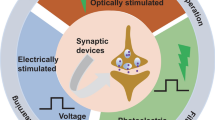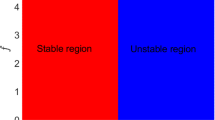Abstract
In consideration of the generation of bursts of nerve impulses (that is, rhythmic oscillation in impulse density) in the ring neural network, a synaptic modification algorithm is newly proposed. Rhythmic oscillation generally occurs in the regular ring network with feedback inhibition and in fact such signals can be observed in the real nervous system. Since, however, various additional connections can cause a disturbance which easily extinguishes the rhythmic oscillation in the network, some function for maintaining the rhythmic oscillation is to be expected to exist in the synapses if such signals play an important part in the nervous system. Our preliminary investigation into the rhythmic oscillation in the regular ring network has led to the selection of the parameters, that is, the average membrane potential (AMP) and the average impulse density (AID) in the synaptic modification algorithm, where the decrease of synaptic strength is supposed to be essential. This synaptic modification algorithm using AMP and AID enables both the rhythmic oscillation and the non-oscillatory state to be dealt with in the algorithm without distinction. Simulation demonstrates cases in which the algorithm catches and holds the rhythmic oscillation in the disturbed ring network where the rhythmic oscillation was previously extinguished.
Similar content being viewed by others
References
Block, H.D.: The perceptron: a model for brain functioning. I. Rev. Mod. Phys. 34, 123–135 (1962)
Friesen, W.O., Stent, G.S.: Generation of a locomotory rhythm by a neural network with recurrent cyclic inhibition. Biol. Cybern. 28, 27–40 (1977)
Fukushima, K.: Cognitron: a self-organizing multilayered neural network. Biol. Cybern. 20, 121–136 (1975)
Fukushima, K.: Neocognitron: a self-organizing neural network model for a mechanism of pattern recognition unaffected by shift in pattern. Biol. Cybern. 36, 193–202 (1980)
Malsburg, Chr. von der: Self-organization of orientation sensitive cells in the striate cortex. Kybernetik 14, 85–100 (1973)
Malsburg, Chr. von der: Development of ocularity domains and growth behaviour of axon terminals. Biol. Cybern. 32, 49–62 (1979)
Mitchel, C.E., Friesen, W.O.: A neuromime system for neural circuit analysis. Biol. Cybern. 40, 127–137 (1981)
Morishita, I., Yajima, A.: Analysis and simulation of networks of mutually inhibiting neurons. Kybernetik 11, 154–165 (1972)
Nagano, T.: A model of visual development. Biol. Cybern. 26, 45–52 (1977)
Nakano, K.: Assosiatron: a model of associative memory. IEEE Trans. Syst. Man Cybern. 2, 380–388 (1972)
Pearson, K.: The control of walking. In: Vertebrates: Adaptation, pp. 55–65. Wessels, N.K. ed. San Francisco: Freeman 1979
Stein, R.B., Leung, K.V., Mangeron, D., Oguztöreli, M.N.: Improved neuronal models for studying neural networks. Kybernetik 15, 1–9 (1974)
Stein, R.B., Leung, K.V., Oguztöreli, M.N., Williams, D.W.: Properties of small neural networks. Kybernetik 14, 223–230 (1974)
Thompson, R.S.: A model for basic pattern generating mechanisms in the lobster stomatogastric ganglian. Biol. Cybern. 43, 71–78 (1982)
Tokura, T., Morishita, I.: Analysis and simulation of doublelayer neural networks with mutually inhibiting interconnections. Biol. Cybern. 25, 83–92 (1977)
Wigström, H.: A neuron model with learning capability and its relation to mechanisms of association. Kybernetik 12, 204–215 (1973)
Wigström, H.: A model for a neural network with recurrent inhibition. Kybernetik 16, 103–112 (1974)
Wigström, H.: Associative recall and formation of stable modes of activity in neural network models. J. Neurosci. Res. 1, 287–313 (1975)
Yagi, H.: Shinkeikei Johokogagu. Tokyo: Denkishoin 1974(in Japanese)
Author information
Authors and Affiliations
Rights and permissions
About this article
Cite this article
Tsutsumi, K., Matsumoto, H. A synaptic modification algorithm in consideration of the generation of rhythmic oscillation in a ring neural network. Biol. Cybern. 50, 419–430 (1984). https://doi.org/10.1007/BF00335199
Received:
Issue Date:
DOI: https://doi.org/10.1007/BF00335199




